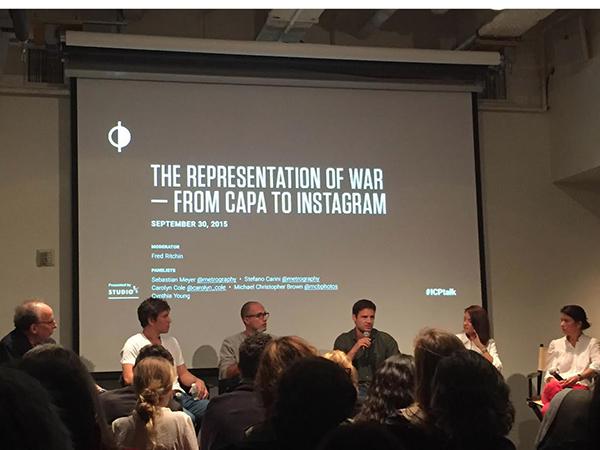Neo-photojournalism: storytelling through the lens of a smartphone

ICP hosted a discussion on the evolution of journalism in today’s digital age.
October 8, 2015
Many people may deem journalism a dying field, yet the topic was very much alive when members and students of the International Center of Photography crammed into a small auditorium to hear five photojournalists speak last Wednesday night.
The presentation, titled “The Representation of War — From Capa to Instagram,” covered the war photography and the changes the industry is undergoing in the digital age. Fred Ritchin, former Tisch Photography and Imaging professor and dean of the School of the ICP moderated the event.
War photographs have historically been displaced from the scenes they depict in time and veracity. Robert Capa, who photographed five wars including World War II, experienced six weeks’ delay before his photos could be published. When they were finally available in print, newspaper editors often fabricated the captions to intensify the drama of the scenes.
Today, photos may be published online within moments of having been shot. Photojournalists aren’t the only ones taking the photos — anyone with a camera phone can play the role of a citizen journalist. Tisch junior Alex Fiszbein, who studies photography, said this decrease in publishing time does not necessarily mean an increase in accuracy, however.
“A lot of people say photography is supposed to be an unbiased view of a situation, right?” Fiszbein said. “But by pointing your camera and by shooting in a specific way and angle, by choosing an exposure, by choosing the lighting, any time that you click the shutter or point your camera, you are partisan.”
Sebastian Meyer, panelist and co-founder of the Iraq-based photo agency Metrography, agreed. Metrography aims to train Iraqi photographers and to present them to mainstream media so the Iraq War may be seen from the point of view of civilians.
“Through social media, ISIS has the same publishing power that we do,” Meyer said. “It has become vital to have first-class photographers to counteract the ISIS propaganda.”
Though the panel discussed a range of different topics, it reached the consensus that the success of such journalists and photojournalists who rely on smartphones is not necessarily a bad thing. Even Metrography Editor-in-Chief Stefano Carini, who lamented the flood of mediocre images and stories being produced, conceded that the ultimate goal of photojournalism is to tell a story.
“I personally don’t care what you use to take the picture with,” Carini said. “I care more about the stories.”
Los Angeles Times photographer Carolyn Cole traditionally took photos for print publications but recently covered the papal visit to New York on Twitter.
“If the printed newspaper is going away, then I must embrace social media and find a voice within that framework,” Cole said. “To me, it’s about trying to relay information and whatever tool that takes.”
The journalists said the goal of photojournalism was not to enact change, but to tell a story. Ritchin directed the conversation toward a slightly different end, countering that the subjects we choose to portray carry meaning beyond story.
“I think the stories we pick to tell are the stories that we want something to change,” Ritchin said. “We just don’t pick anything.”
Fiszbein, who spent a semester in Cuba working on a documentary, reflected on the nature of the news as a whole.
“By telling a story, you’re saying that there is something to be told,” Fiszbein said. “You’re saying either there’s an issue or this is a great thing … It is activism.”
Email Abigail Weinberg at [email protected].


























































































































































